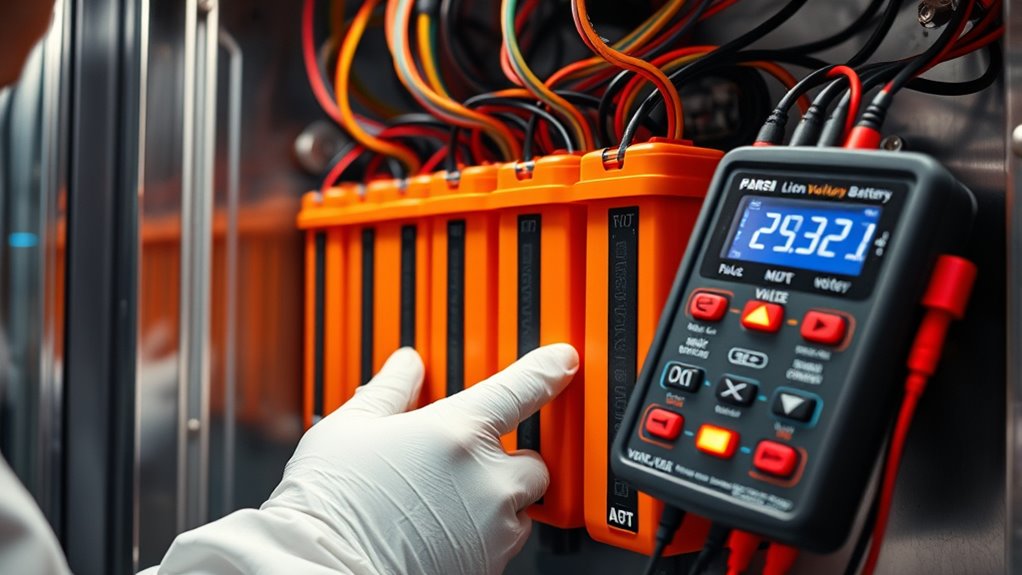To maintain batteries for electric instrumentation, regularly inspect for corrosion, leaks, and secure connections. Use proper charging techniques, avoiding overcharging and extreme temperatures to extend lifespan. Store batteries in a cool, dry place with partial charges, and monitor their capacity over time. Handle damaged batteries carefully and dispose of them responsibly. Following these steps helps guarantee peak performance and safety—continue with the key tips to keep your batteries in top shape.
Key Takeaways
- Regularly inspect terminals for corrosion, leaks, and secure connections to prevent performance issues.
- Monitor battery voltage and capacity over time to detect early signs of degradation.
- Maintain proper charging practices, avoiding overcharging and deep discharges, with temperature control.
- Store batteries in a cool, dry place at partial charge and perform periodic capacity tests before long-term storage.
- Follow safety protocols during handling, cleaning, and disposal to ensure safe and environmentally responsible maintenance.
Understanding Different Types of Batteries Used in Electric Instruments
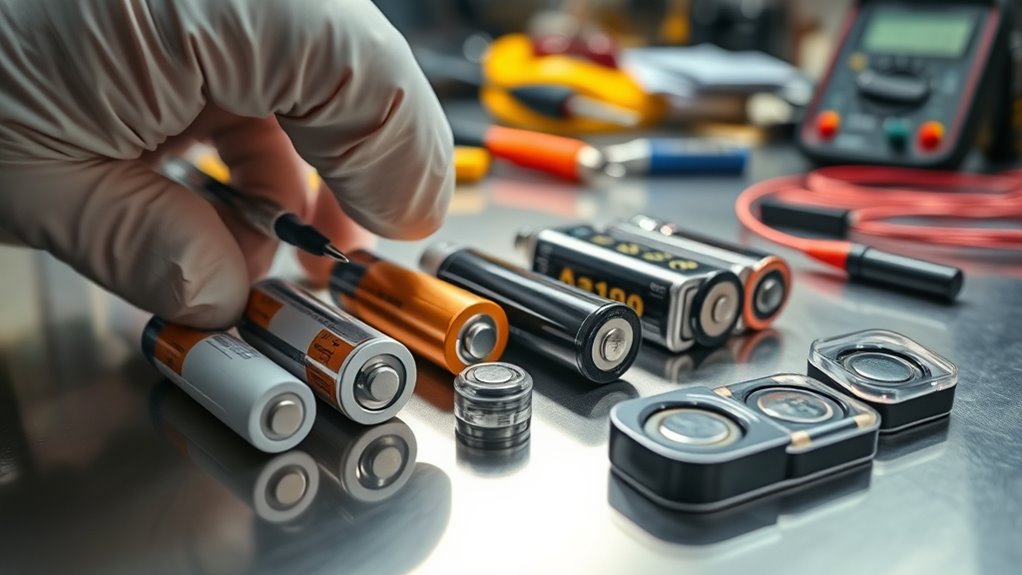
When it comes to powering electric instruments, understanding the different types of batteries is essential for peak performance and maintenance. Battery chemistry determines how the battery generates power and affects its lifespan, safety, and charging requirements. Common chemistries include lithium-ion, nickel-metal hydride (NiMH), and lead-acid, each suited for specific applications. Battery capacity, measured in milliamp-hours (mAh) or amp-hours (Ah), indicates how long a battery can supply power before needing a recharge. Knowing these factors helps you choose the right battery for your instrument, ensuring ideal performance and longevity. Different chemistries also influence weight, cost, and recharge cycles, so understanding these distinctions allows you to make informed decisions for effective instrument operation.
Regular Inspection and Visual Checks for Battery Health
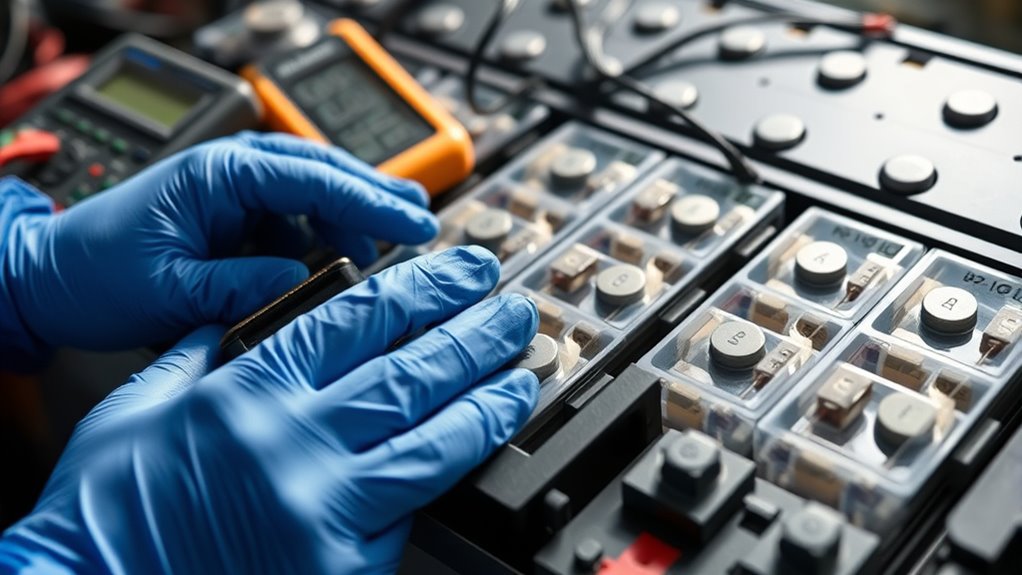
Regularly inspecting your battery helps catch issues early. Look for signs of corrosion on terminals, make sure connections are secure, and check fluid levels if applicable. Staying vigilant keeps your battery in good shape and prevents unexpected failures. Additionally, understanding resources and tools available can assist in proper maintenance and troubleshooting.
Check for Corrosion Signs
To maintain your battery’s health, it’s essential to visually inspect it for signs of corrosion. Look closely at the terminals and surrounding areas for any corrosion signs, such as white, blue, or greenish deposits. These deposits often indicate electrolyte leakage, which can harm the battery’s performance. If you notice corrosion signs, address them promptly to prevent further damage. Electrolyte leakage not only diminishes battery efficiency but can also cause safety hazards. Regular checks help you catch problems early, saving you time and money. Keep your battery clean and dry, and ensure that any corrosion is carefully cleaned away using appropriate methods. Staying vigilant through visual inspections is a key step in maintaining ideal battery health and longevity. Additionally, understanding the importance of battery maintenance can help extend the lifespan and performance of your electric-instrumentation batteries.
Inspect Terminals and Connections
Inspecting your battery’s terminals and connections is crucial for maintaining overall health. You should regularly check the terminal connectors for signs of corrosion, looseness, or damage. Make certain that the cable integrity remains intact—look for frayed wires, cracks, or wear that could cause poor contact. Tighten any loose connections to prevent voltage drops and potential failures. Clean off any corrosion with a wire brush or a mixture of baking soda and water, and make sure the terminals are dry before reconnecting. Properly maintained terminal connectors promote efficient power transfer and reduce the risk of electrical issues. Regular inspections help maintain cognitive function and overall performance of your equipment. Consistent visual checks help catch problems early, extending your battery’s lifespan and ensuring your equipment stays operational.
Monitor Fluid Levels
Monitoring your battery’s fluid levels is essential for maintaining its performance and longevity. Regularly check the electrolyte levels to ensure they’re within the recommended range. Low fluid levels can cause overheating and reduce battery life, while overfilled cells may leak acid. When inspecting, look for consistent fluid heights and clear, clean electrolyte. Use a suitable tool to top off with distilled water if levels are low—never add acid. Keep an eye on signs of corrosion or leaks around terminals. Proper electrolyte monitoring helps prevent damage caused by dry cells or overfilled ones. Additionally, regular inspections can help identify early signs of battery fires or other safety issues.
Proper Charging Techniques to Maximize Battery Life
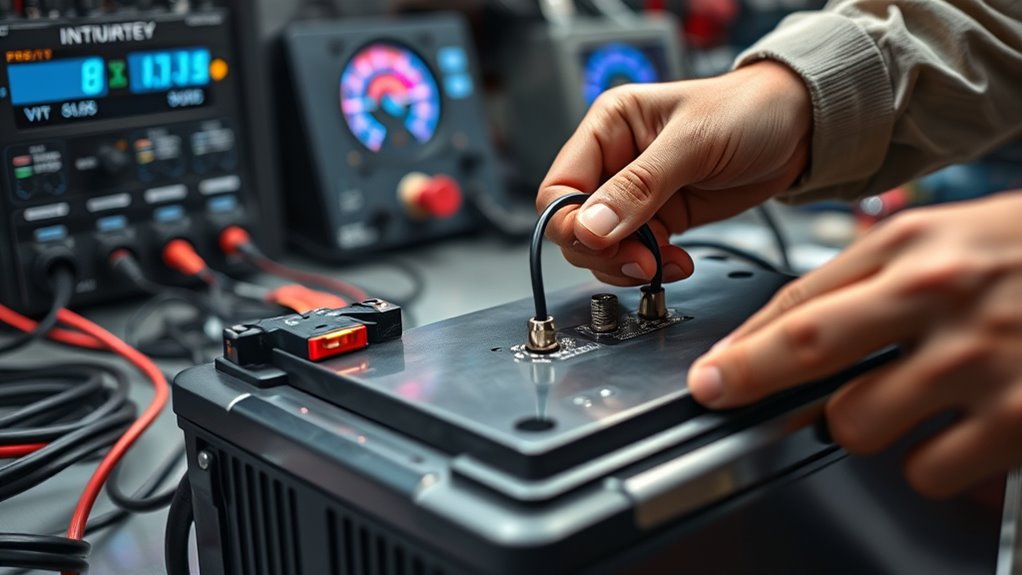
To get the most out of your battery, you should charge it during ideal times, like when it’s around 20% to 80% full. Avoid leaving it plugged in for too long, as overcharging can harm its lifespan. Using proper charging techniques helps guarantee your battery stays healthy and performs well over time. Understanding the importance of proper care can further extend your battery’s longevity.
Optimal Charging Times
Choosing the right times to charge your battery can substantially extend its lifespan. Aim to keep your device within moderate charge levels, avoiding frequent deep discharges or full charges that can wear out the battery faster. Charging cycles, which involve fully charging and then discharging your battery, should be minimized to prevent unnecessary stress. It’s best to recharge when your battery drops to around 20-30% and unplug near 80-90%. Regular battery calibration, done by fully charging and discharging periodically, helps maintain accurate battery level readings, ensuring ideal performance. Additionally, understanding the contrast ratio of your device can help optimize its performance and longevity. By timing your charges wisely and practicing proper calibration, you help preserve your battery’s health and maximize its overall lifespan. Proper timing can lead to fewer replacements and better reliability in your electric-instrumentation.
Avoid Overcharging Risks
Overcharging your battery can considerably shorten its lifespan, so it’s crucial to use proper charging techniques. To prevent overcharge risks, focus on overcharge prevention strategies like disconnecting the charger once the battery reaches full capacity. Implementing voltage regulation helps maintain safe voltage levels, avoiding excessive current that can damage the battery. Modern chargers often feature automatic shut-off or trickle charge options, which are essential for preventing overcharging. Always monitor the charging process and avoid leaving batteries connected longer than necessary. By controlling voltage levels and using reliable chargers with built-in safeguards, you ensure your battery stays healthy and operates efficiently. Proper charging techniques not only extend battery life but also reduce the risk of overheating or other damage caused by overcharge conditions. Additionally, understanding the importance of sound design in media can help optimize the overall performance of electronic devices that rely on battery power.
Temperature Management and Its Impact on Battery Performance
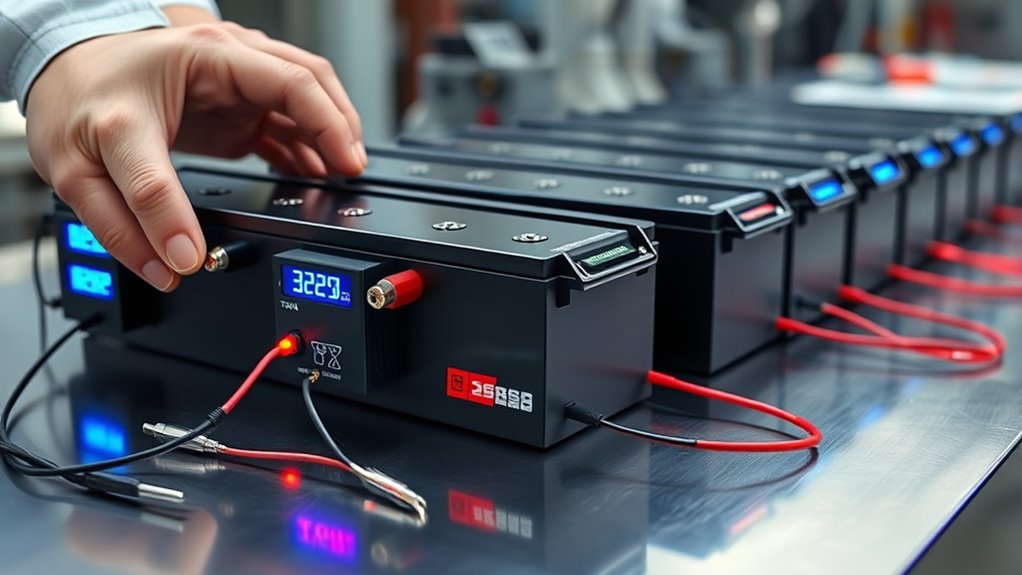
Temperature plays a crucial role in determining your battery’s performance and lifespan. Proper thermal regulation helps keep the battery within ideal temperature ranges, preventing damage caused by extreme heat or cold. Temperature effects are significant: high temperatures can accelerate chemical reactions, leading to quicker capacity loss and potential overheating. Conversely, cold temperatures reduce chemical activity, decreasing capacity and making batteries less efficient. Maintaining consistent temperatures minimizes stress on the battery, ensuring reliable performance and longer life. You should avoid exposing your batteries to rapid temperature fluctuations or extreme environments. Using cooling systems or insulating materials can help manage temperature effectively. Additionally, Kia Tuning options such as ECU remapping and suspension upgrades can influence thermal management by optimizing engine and vehicle performance. By controlling thermal regulation, you ensure your batteries operate smoothly, retain their capacity longer, and reduce the risk of costly failures.
Storage Practices for Long-Term Battery Preservation
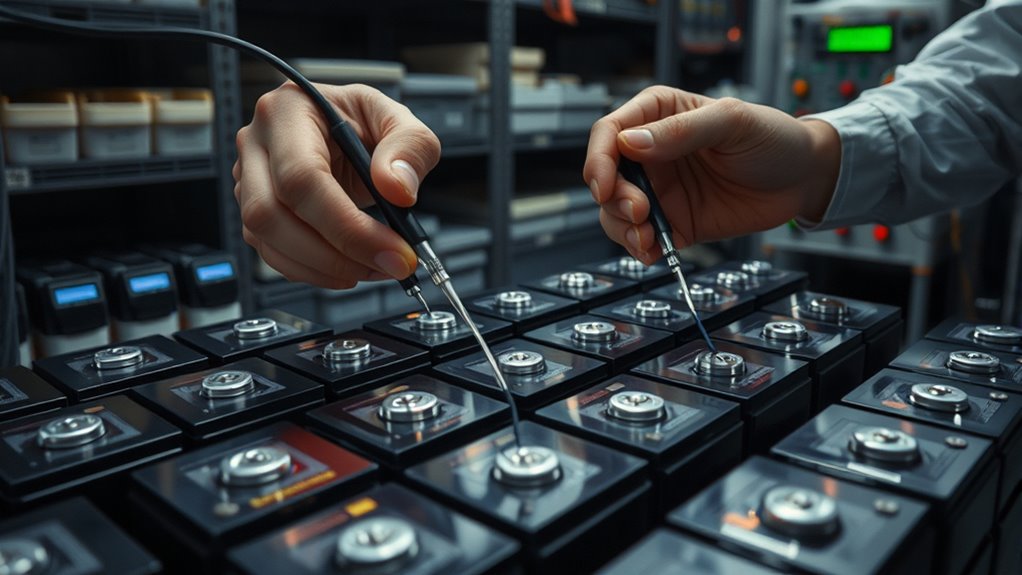
To preserve your batteries effectively over the long term, proper storage practices are essential. Store batteries in a cool, dry place away from direct sunlight and extreme temperatures. Keep them at a partial charge—around 40-60%—to prevent capacity loss. Before storing, perform battery capacity testing to ensure they hold a sufficient charge. Regularly check stored batteries for signs of deterioration or leakage. When batteries reach the end of their lifespan, recycle them responsibly through battery recycling programs to prevent environmental harm. Avoid storing batteries in metal containers or with conductive materials that could cause shorts. Proper storage not only extends battery life but also ensures safe handling and peak performance when you need them. Eye patch benefits and the importance of consistent maintenance and mindful storage are key to long-term battery preservation.
Recognizing and Addressing Signs of Battery Degradation
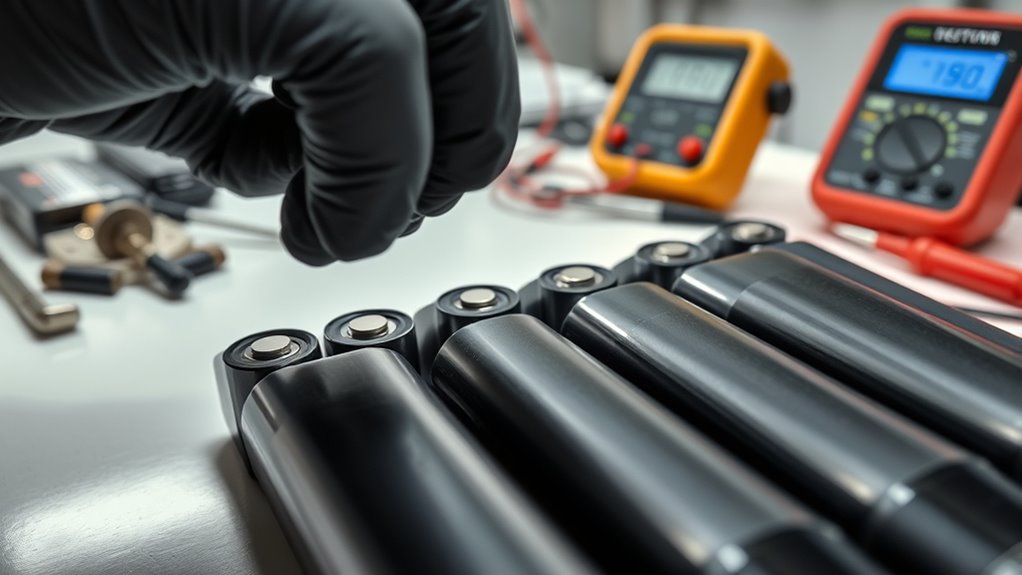
Recognizing the early signs of battery degradation is essential to maintaining ideal performance and preventing unexpected failures. You should monitor changes in battery capacity, as a noticeable drop indicates the battery isn’t holding charge as well as before. Voltage stability also serves as a key indicator; fluctuations or drops in voltage under normal load suggest deterioration. If your equipment shows reduced runtime or inconsistent power output, these are clear signs that the battery is aging. Understanding the Vortex can help you stay mindful of your energy levels and emotional well-being during the process. Acting early by testing voltage levels regularly and tracking capacity over time can extend your battery’s life and ensure reliable operation. Staying vigilant helps you catch problems before they escalate, saving you time and costly replacements.
Safe Handling and Disposal of Batteries
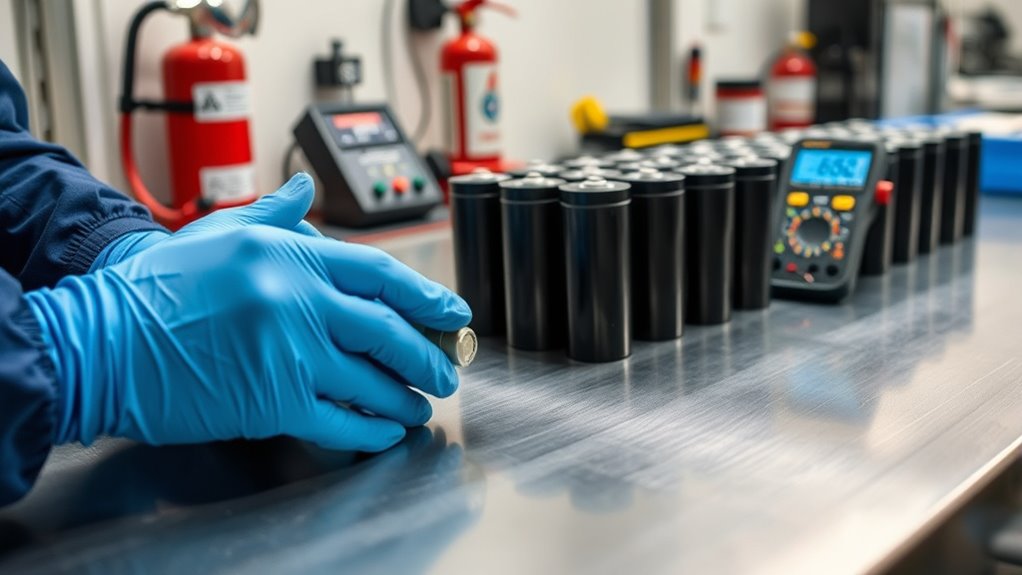
Handling and disposing of batteries safely is essential to protect yourself, others, and the environment. Always wear gloves and eye protection when handling damaged or leaking batteries. Dispose of batteries as hazardous waste according to local regulations, never in regular trash. Proper battery recycling prevents environmental contamination and recovers valuable materials. Use designated collection sites for recycling, and never puncture or incinerate batteries. Below is a quick guide:
| Safe Handling Tips | Disposal Guidelines |
|---|---|
| Wear protective gear | Recycle batteries properly |
| Avoid contact with leaks | Do not burn or puncture |
| Store in a cool, dry place | Follow hazardous waste laws |
Always stay informed about local recycling programs to guarantee safe, eco-friendly disposal.
Implementing Preventive Maintenance Schedules
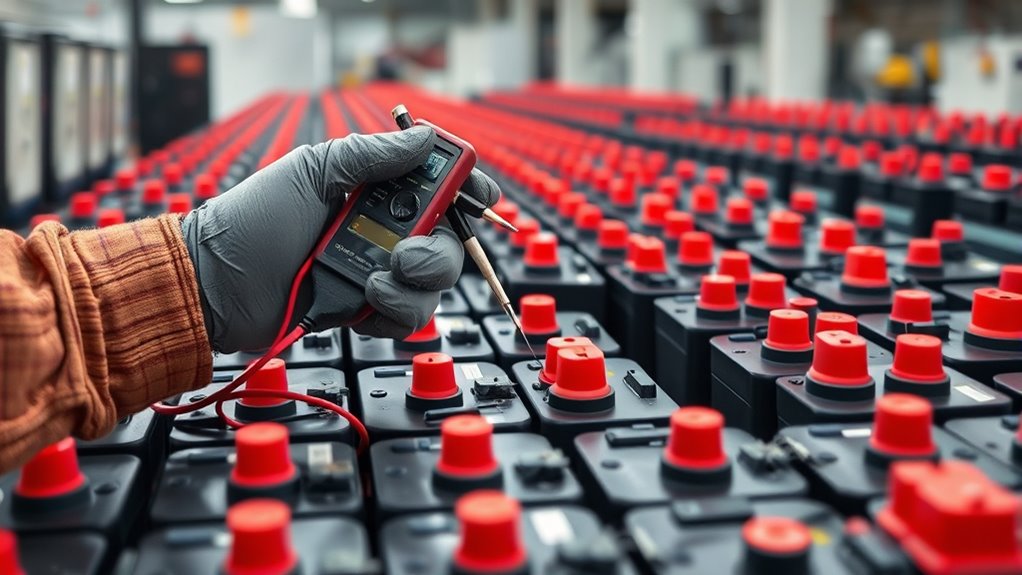
Implementing a preventive maintenance schedule is essential for ensuring your batteries perform reliably and last longer. Regular checks of your battery pack help identify issues before they escalate, preventing unexpected failures. Schedule inspections of terminal connections, electrolyte levels, and overall cleanliness. Monitor the energy density of your batteries, as it indicates their capacity to store and deliver power efficiently. Consistent maintenance reduces the risk of capacity loss and prolongs the lifespan of your battery pack. Keep detailed records of each maintenance activity to track performance trends. By sticking to a routine, you optimize battery performance, reduce downtime, and maintain safety standards. A well-planned schedule ensures your electric-instrumentation operates smoothly, maximizing the reliability and efficiency of your energy storage system.
Frequently Asked Questions
How Do I Choose the Right Battery for My Electric Instrument?
When choosing the right battery for your electric instrument, consider your power storage needs and the latest battery technology. Think about how much energy your device consumes and how long it needs to operate. Select batteries with reliable power delivery, long cycle life, and compatibility with your instrument’s specifications. By understanding these factors, you guarantee peak performance and longevity for your device’s power source.
What Are Common Causes of Unexpected Battery Failure?
Unexpected battery failure often results from issues like battery corrosion, which damages terminals and hampers power flow. Temperature effects also play a significant role; excessive heat accelerates chemical reactions, reducing battery lifespan, while cold temperatures can diminish capacity. You should regularly inspect your batteries for corrosion, keep them at ideal temperatures, and guarantee proper maintenance to prevent these common causes of failure and extend your instrument’s performance.
How Can I Extend Battery Lifespan Through Daily Practices?
To prolong your battery’s performance, practice proper daily routines. Regularly calibrate your battery to guarantee accurate readings and prevent overcharging or undercharging. Monitor electrolyte levels consistently to avoid dry or overfilled cells. Keep your battery clean and cool, and avoid deep discharges. By balancing battery calibration with diligent electrolyte monitoring, you’ll boost longevity, prevent premature failure, and preserve power, promoting a prolonged, productive lifespan with minimal mishaps.
Are There Specific Safety Measures During Battery Charging?
When you’re charging batteries, prioritize safe charging practices by using proper protective gear like gloves and goggles to prevent injury. Make sure the charging area is well-ventilated to avoid buildup of dangerous gases. Never leave batteries unattended during charging, and use compatible chargers to prevent overcharging. Always follow manufacturer instructions, and check for any signs of damage before beginning. These safety measures help protect you and guarantee ideal battery performance.
What Maintenance Tools Are Essential for Battery Upkeep?
You need essential tools like a multimeter to monitor battery voltage and a hydrometer for electrolyte levels, especially with different battery chemistries. A terminal cleaner helps prevent corrosion, while a charger with adjustable settings guarantees proper charging cycles. Regularly inspect and maintain these tools, and follow manufacturer guidelines, to keep your battery performing well and extend its lifespan. Proper upkeep minimizes risks and optimizes battery efficiency.
Conclusion
By understanding battery types, inspecting regularly, charging properly, managing temperature, storing correctly, recognizing degradation signs, handling safely, and maintaining schedules, you guarantee longevity, reliability, and safety. Consistent attention, proactive care, and informed practices safeguard your equipment, extend battery life, and prevent unexpected failures. With these strategies, you empower yourself to maintain peak performance, reduce costs, and promote safety—making battery maintenance an effortless part of your routine and a crucial aspect of your equipment’s health.
With a heart that soars as high as the skies, Aria, affectionately known as “Skylark,” is the driving force behind Soaring Skyways. Her journey into the gliding world began as a young dreamer gazing up at the soaring birds, yearning to experience the weightlessness and freedom they embodied. With years of experience both in the cockpit and behind the scenes, Aria’s commitment to the gliding community is unwavering.
